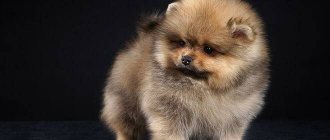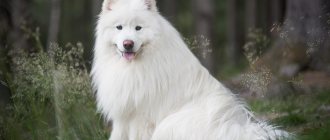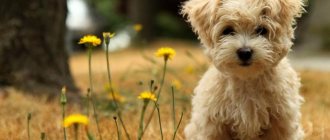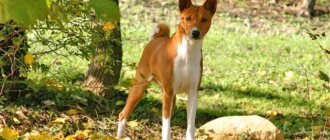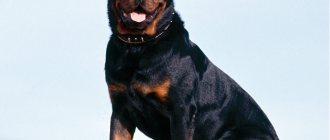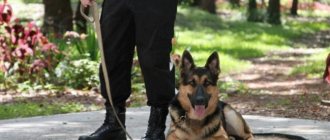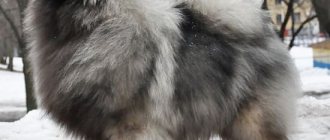Every dog lover has their own “type”. Whether you prefer big or small dogs, long-nosed or short-legged dogs, curly-haired dogs or wolf-like dogs, there is a breed for you. And if you're partial to dogs that look like bears, you're in luck! There are many dogs with thick fluffy fur and an external resemblance to a clubfoot.
Keep in mind that bear-like dogs are not suitable for everyone. With a few exceptions (we're talking about Spitz), these dogs look like bears in part because they are large, and in some cases very large, unlike Pomeranians, which look like teddy bears. So these pets may not be suitable for living in apartments or small houses.
Most shed heavily and require regular grooming to keep their coat clean and healthy. And almost all bear-like dogs were bred for cold climates, so they do not tolerate hot weather well and cannot be kept outside in high temperatures.
But if you think you're ready for a furry, bear-like pet in your home, check out the dog breeds below.
Pyrenean mountain dog
These heavily furred white dogs are gentle giants unless one of their pack is in danger. Bred in the Pyrenees Mountains, the range that separates France from Spain, Pyrenean Mountain Dogs are moderately active dogs that require a nice walk in the park and a cool place to rest.
Their coat is naturally resistant to dirt and tangles, but requires brushing once a week. A couple of times a year, Pyrenean Mountain Dogs will shed heavily, so have a powerful vacuum cleaner ready. These intelligent, affectionate dogs are great with children, but are not suitable for apartments or hot climates. Oh, and they like to bark —a lot of bark.
Maltipoo
The Maltipoo is a cross between a Poodle and a Maltese. They are small dogs, standing around 35 centimeters at the shoulders, making them ideal for apartment living.
The Maltipoo is a cute breed that is also extremely intelligent and loving, making them suitable for training and fun in a family setting. One disadvantage is that the Maltipoo can suffer from separation anxiety if left alone for long periods of time.
These little dogs love to be groomed and enjoy a little daily exercise. Although Maltipoos can live up to 13 years, they can be vulnerable to skin diseases, epilepsy and patellar luxation.
Chow chow
Perhaps the Chow Chow is the most well-fed of the bear-like dogs. It is given volume by fluffy coarse fur and a luxurious mane of hair around its muzzle. Their resemblance to clubfoot is given by their round muzzle with a short nose and deep-set eyes. Their double coat of fur sheds heavily, so they need to be brushed several times a week.
Did you know that originally bred in China as hunting and guard dogs, Chow Chows are considered one of the oldest dog breeds.
The Chow Chow can be a little aloof and wary . To ensure your pet becomes a well-socialized adult dog, be sure to introduce it to children and other dogs as a puppy and teach it obedience. These furballs require a moderate amount of exercise, run very little, and can adapt to apartment life.
Behavior
The sizes, temperaments and external characteristics of breeds that resemble bear cubs are very different from each other, but all dogs have similar features:
- devotion to the owner and family;
- intelligence, intelligence and good memory;
- a fair amount of stubbornness;
- tendency to dominate.
Due to the abundant fur, the movements of most animals seem clumsy, which further emphasizes their resemblance to bears.
Pomeranian Spitz
Is any living thing more like a stuffed toy than a Pomeranian puppy? Although they didn't make our list of fox-like dogs, the furry little Pomeranian puppies definitely have a fox-like personality that only intensifies as they get older.
Generally sweet and friendly, Pomeranians love to play indoors with a ball or squeaky toy, but do not tolerate prolonged exercise outdoors in hot weather. Although they love children, their diminutive size - they weigh only two to three kilograms - means they may not be suitable for families with rambunctious children. And this luxurious fluffy double fur? He sheds a lot and needs to be brushed several times a week.
Education and obedience
An active and playful mini-Spitz, he is very smart. Training is an interesting game for him. From the very beginning of being in the house, you should not allow the puppy to do what an adult dog is forbidden to do. Sleeping and playing on the bed can be very dangerous for your Pomeranian - the baby could fall and get hurt. Barking under the table, begging for food from the owner, is a manifestation of poor upbringing.
Raising a dog is a very responsible occupation.
The dog must know that it can only play with and carry its own toys in its mouth. By being persistent in raising your Spitz and making the commands more difficult, you can get a friend for the whole family.
Circus tricks are not at all difficult to learn for a Pomeranian. Good contact with the dog and understanding of the pet’s wishes will provide the owner with motivation to learn new commands.
The Pomeranian's stubbornness and loud barking can be stopped with an offer to play. All family members must be equally persistent in their demands, otherwise the dog will understand and will continue to violate prohibitions, causing the indignation of the owners.
Dog handlers consider the Spitz to be an easily trained dog. With a competent approach and love for the bear cub, you can receive diplomas and control the dog at any, even noisy, events. Obedience and following commands during walks are the main things a Mini Spitz is capable of.
Newfoundland
If you notice a bear that likes to spend time in the water and constantly sticks its tongue out, it may not be a bear at all. It could be a Newfoundland! Bred in the ice-covered Canadian province of Newfoundland and Labrador as marine working dogs, these large dogs became famous for their fearlessness in rescuing drowning people.
Fun fact: Newfoundlands are one of the best mountain dog breeds that love adventure and water fun!
Today's Newfoundlands are known for their sweet dispositions and love of children. However, these wonderful companion dogs can literally outweigh their owners! This giant breed of dog requires plenty of space to live, plenty of people or animals to socialize and play with, moderate exercise, and owners who tolerate shedding and excessive drooling.
Mating
Usually dogs of the same class are taken for mating. Ordinary dogs are never mixed with show class dogs. For mating of high-class breeds, the nursery always takes permission and confirmation of class membership.
For mating, a neutral territory is chosen, where the chow chows are introduced to each other. The process may not begin immediately; dogs may first get to know each other by sniffing and playing.
Pairs are selected taking into account the character, size and classes of dogs . The age of males for mating should be about 2 years , females are determined by the third heat. For mating, you need a quiet place where the dogs will not be distracted.
Read a detailed article on the topic: “Everything you need to know about breeding dogs: appropriate age, what to do if it doesn’t work out, rules and tips.”
Caucasian Shepherd Dog
The Caucasian Shepherd Dog, also known as the Russian Bear Dog , was bred to be a fierce and fearless protector of the herds in the Caucasus Mountains separating Europe from Asia. Although this powerful, giant breed probably no longer fends off attacks from bears or wolves, it still protects its home and cares for its family - to the point that it can be aggressive with strangers and other people's animals.
Since male Caucasian Shepherds can tip the scales at up to 100 kg (!), early training and socialization are a must. Unlike lap dogs, this is not a breed for beginners . Its double coat sheds heavily, so the pet will have to be brushed several times a week.
How to make a choice?
This is a very responsible choice and there is little resemblance to a bear; many factors need to be assessed comprehensively:
- Character and behavior – you should not get a wayward dog if you are not ready to train him regularly;
- Conditions of keeping - do not take a sled dog if you cannot run races with it or let it out in a large enclosure;
- Goal - decide whether you need a security guard or a companion;
- Are you expected to live together with other pets?
- Before bringing a dog into your apartment, make sure that all family members are not allergic;
- Having enough time to care for your pet.
Samoyed
Cute, cheerful Samoyeds were bred in Siberia and northern Asia to withstand some of the coldest temperatures on the planet. Today, these “polar bears” thrive in an air-conditioned home during the summer months.
IMPORTANT! Samoyeds love their family and do not do well if left alone for long periods of time.
These white dogs' signature fluffy coat sheds almost all the time , so they require brushing several times a week. But one look at this cute, “smiling” face, and you will forgive her the extra work.
Description of the breed with photos
The bear-type Pomeranian is a miniature breed. Its build is similar to that of Spitz dogs. The same applies to character. A distinctive feature of the dog is its head, which is more round than that of other Spitz dogs. The nose of the orange is 3 to 5 cm long, flattened and somewhat reminiscent of a pug.
This, together with the fluffy hair that emphasizes the shape of the head, gives the bears’ faces a special charm. Animals with a nose shorter than 3 cm, although they look more decorative and toy-like, are not recommended for the establishment, as they have serious health problems associated with disorders of the respiratory system.
Important! Dogs with excessively short muzzles are bred by breeders who, in order to make a quick and significant profit, breed dogs paying attention only to their appearance. Such individuals have a low quality of health.
The remaining characteristics of the bear-type Pomeranian are as follows:
- strong body;
- round head;
- flattened muzzle;.
- ears are small and round;
- round eyes, close to the nose;
- the chin is slightly raised;
- the tip of the nose is slightly turned up;
- wool is abundant;
- tail lying on the back.
The breed is very different from all other dogs of the dwarf category: Pomeranians have good health and the character characteristic of varieties belonging to the working category. The intelligence of the mini Spitz is high.
Size and weight
The height of the dog at the withers is from 18 to 22 cm . The standard weight should be from 2 to 3 kilograms. Males are slightly larger than females. If an animal does not meet the canine standards of the breed in terms of height or weight, then at exhibitions it receives reduced marks when the deviation from the norm is insignificant, or is rejected and not allowed for breeding if the defect is severe.
Color and coat type
The dog's coat is long, but straight, with a well-developed thick undercoat. The colors of orange Spitz are varied - 12 types are officially approved. There are also unregistered options. The most popular are fiery colors: red and red. Others are not inferior to them in attractiveness: white, sand, chocolate (brown), black, gray, beige. Also, according to the standard, a doll Spitz can have two-color wool.
Keeshond
If you are looking for a medium-sized bear dog that will be a loving companion and devoted family dog, the Keeshond fits the bill. These fluffy balls of gray, black and cream fur were bred as companion dogs for Dutch bargeeers, a role they still take seriously to this day.
Keeshonds enjoy spending time with their people and do not like to be left alone for long periods of time. They quickly adapt to apartment life, small children and other pets, and as long as you promise to adore and cuddle them, you will have a loving friend for life.
Poodle
Boundless energy and a sunny disposition make the Poodle an excellent family dog. No breed has a more developed sense of humor than the poodle.
Poodle puppies, especially the chocolate ones, look like teddy bears. So you can't be sure which one is a poodle and which one is a toy. White, blue and peach poodles are also not uncommon. A dog's fur does not cause allergies, but requires regular care and maintenance. You will have to use not only shampoo, but also wool conditioner. From the age of six weeks you need to accustom your pet to combing. A poodle's haircut can highlight its beauty and grace.
Eurasier
Similar in size to the Keeshond, the Eurasier also shares some of its best qualities, including its bear-like appearance and desire to be close to its human family. Considered a purebred breed , the Eurasier was developed during the 1960s and 1970s when a German dog lover crossed a Chow Chow and a Wolfspitz. Today, Eurasiers are popular in European countries with colder climates, but are less known in other parts of the world.
These friendly fluffies have a double coat, like their immediate ancestors, and will shed their undercoat several times a year. So plan on brushing and vacuuming frequently! Take a look at these German dog breeds that will make great companions.
Fox terrier
Fox terrier
Remarkable strength, amazing endurance, agility and flexibility. These character traits are inherent in the Fox Terrier, bred in the British Isles during the heyday of the Roman Empire. Initially, animals whose height did not exceed 40 cm were used to catch rats in houses and barns. Since the 17th century, brave four-legged animals have become indispensable assistants in hunting foxes and badgers. Compactly built dogs have innate qualities: an aggressive attitude towards prey, assertiveness, reckless courage and a death grip.
A properly trained fox should, without fear, climb into a dark hole, strangle the animal (sometimes superior in size and strength to the temperamental little hunter) and pull the trophy to the surface of the earth. Fox Terriers are created to work, so dog breeders advise active people who love walks and long games with their pets to own these cute creatures.
Tibetan mastiff
Do you need a furry pet? Do you want a big dog that looks like a bear? We recommend the Tibetan Mastiff, a bear-like dog originally bred as a guard dog in the Himalayan highlands, but which is now just as happy to serve as a playful and protective family companion.
Tall and stocky but not giants, Tibetan Mastiffs have a thick double coat and bushy tail, but they shed surprisingly little . Brushing them several times a week will help keep their fur clean. You'll also want to check those furry paws for any accumulated dirt. And most importantly, keep this chubby little buddy indoors during the hottest part of the day.
Based on materials from: www.rd.com
Peculiarities
Large and medium-sized breeds are of ancient origin and are intended to be kept only in private houses with a plot. In childhood, they undoubtedly resemble teddy bears, but as they grow older, their appearance changes. Dimensions, the need for large space and a thick coat make it difficult to live in apartment conditions. But it is the warm fur, reminiscent of a bear skin, that provides comfort when the dog is on the street or in an unheated room on frosty days.
Large dogs show a desire for leadership, and therefore they require more strict training and constant training. Miniature breeds resemble clumsy, fluffy bear cubs, causing emotions of tenderness and admiration. They adapt perfectly to living in an apartment. They are excellent companions and make great family pets.
French lap dog - Bichon Frize
German Spitz
The lap dogs were not bred artificially. Small white dogs with fluffy curly or wavy hair lived on the coast and islands of the Mediterranean Sea and became the ancestors of all lapdogs.
The FCI groups them into the Bichon group. This name comes from the French word bichonner - to curl, care for, dress up.
French sailors were the first to find Bichons. At first, dogs traveled on ships where they worked as rat catchers. During the Renaissance, they spread to France, England, Italy, Spain, and became favorites of the aristocracy and circus performers. In each country, lap dogs were improved in their own way.
French lapdog puppy.
The Bichon Frize breed was developed in France and Belgium. These are small but dense dogs with ears hanging down along the cheeks. The wool curls into springy curls in a spiral and grows up to 10 cm.
The only color of the Bichon Frize is white.
Bichons are calm, good-natured dogs. They do not show aggression towards people and animals, even strangers. French lap dogs have a stable psyche. Dogs easily adapt to the owner's temperament and do not bark without a reason. The lifespan of a Bichon Frize is 12 to 15 years.
Petit (petit) Brabançon
The Petit Brabançon is a small dog (up to 28 cm at the withers) with a weight ranging from 3–6 kg. But the dog itself does not know about this; in its mind, it is a big brave dog. And this behavior of hers is already touching. True, this also leaves an imprint on the upbringing of the pet. He needs early socialization and knowledge of at least the simplest commands. But the pet’s amazing muzzle, similar to a monkey, is capable of expressing a variety of emotions.
The Petit Brabançon has a developed sense of self-esteem and is not at all shy
Petit Brabançons become very attached to their owner and have a hard time withstanding separation, so it is better to get them for families where the main person in the dog’s life will often be at home. The pet’s short, shiny coat does not require complex care, and in general, maintenance will not be too difficult even for a beginner.
Coton de Tulear
Miniature Bichons are native to Madagascar. The first dogs were brought to Europe by tourists in the 1960s. Madagascar lap dogs were in great demand and were expensive. The sale of one puppy paid for the trip and vacation on the island.
The height of the Coton de Tulear is up to 28 cm. The pliable soft wool has a texture reminiscent of cotton. The color is exclusively white. Madagascar Bichons shed moderately. Moreover, the hair does not fall and fly around the house in clumps, but gets tangled in a thick fur coat. If the wool is not combed every day for 15–20 minutes, it becomes tangled.
The Madagascar Bichon quickly becomes part of the family and is considered an ideal companion. Easy to learn, remembers tricks. He loves to “perform” in front of the public in order to please his owner, for which he received the nickname “clown” in France.
Training
At home, the behavior of these seemingly cute dogs is often destructive. They chew on sofas, climb on chairs and tables like cats, steal food from countertops and cause damage to any thing that is “in the wrong place.” But this is what representatives of this breed do in the absence of appropriate upbringing.
Training a husky will not be easy, because these animals are very capricious. Despite the warm feelings they have for their owner, dogs often distance themselves from him. To make them obey, you will have to show persistence and patience.
Unfortunately, in the process of training a husky, you cannot do without punishment. This is not about beating! Whenever the dog begins to behave badly, for example, barking loudly for no reason, you need to raise your voice at him, saying “Ugh” out loud.
He should associate this command with a ban on specific actions. Huskies are very smart, so they will quickly remember it. A 2-month-old puppy of this breed can be taught traditional dog commands. Consider an example of teaching the “sit” command:
- Bring the animal to a calm state.
- Stand in front of him. Say “sit” clearly and loudly.
- Apply gentle pressure to the back of your dog's back to help him get into a sitting position.
- Repeat “sit” again.
- Reward the animal with a treat or a pat on the head.
It is important to form a trusting relationship between you and the dog. You should not impose authority on him by force, as this will only increase stubbornness on his part. Try to act calm and confident when interacting with your husky.
This will allow him to realize your primacy. To keep your dog obedient and not try to run away, never treat it like a member of your family. Remember these basic rules:
Try to act calm and confident when interacting with your husky. This will allow him to realize your primacy. To keep your dog obedient and not try to run away, never treat it like a member of your family. Remember these basic rules:
- Don't let your pet sleep in the same bed with you.
- Correct his behavior when he shows stubbornness.
- Do not allow huskies to bark at people who come into the house.
- Don't feed him table food.
It is also not recommended to give your dog soft toys that he can chew. Tormenting objects awakens in him the instinct of a wolf, that is, a predator. At this seemingly game moment, his nerves are on edge. An overly active husky will not listen to you if you allow him to tear at stuffed animals.
And lastly, run with your dog as often as possible, she loves it. Physical activity will definitely do her good. Plus, going for a run with your four-legged friend will strengthen your bond.
Animal character
The devotion of these dogs is legendary. There are cases where pets refused food if it had to be taken from someone other than their owner.
The main features of Korean Jindo are devotion and courage, bordering on the impossible.
Their incredible courage makes them excellent hunters of medium and large game.
Chindos are extremely energetic; if you do not give them proper exercise, your home environment may suffer.
Walking with other dogs should be done under the supervision of the owner; they may become aggressive and start fighting for territory.
They are wary of strangers and if there is a danger to the owner, they will rush to his defense. These qualities make Chindo excellent guards and watchmen.
Distinctive features
The main features that distinguish this breed from others are:
- The head is large and wide. It is found on a short neck that is set well on the shoulders.
- The eyes are oval, small in size, color from blue to brown. Located close to the nose.
- The ears are small, round and thick. Slightly tilted forward and hidden in thick fur.
- The muzzle is wide along its entire length and medium in size. Wool adds volume and roundness.
- The tongue is blue or purple.
- The nose is large and wide.
- Scissor bite. The teeth are straight, the upper jaw protrudes in front of the lower jaw.
- The body is powerful, the sternum is strongly pronounced, the back is strong.
- The tail is hooked, fits well on the back, set high.
Swedish Lapphund
Weight - 14-20 kg, height - 40-50 cm, life expectancy - 12-14 years. Depending on the density of their coat, Swedish Lapphunds can look like wolves or sloth bears with their narrow muzzle and pointed ears. Their fluffy, curly tail and cheerful disposition make Swedish Lapphunds excellent playmates. As herding dogs, puppies are good at learning commands and enjoy spending time outdoors.
